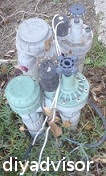 |
| Painter's hat |
Supplies and Tools:
Blue wall paint
Can opener (for Paint)
Gloves nitrile disposable
Ladder 4 to 6 feet
Painting brush 2-inch
Painting ceiling edger
Plastic liner
Paint frame and painting roller
Paint stick (stirring)
Paint tape (2 inch or wider)
Paint stirrers
Metal paint tray
9-inch roller cover
Tarp for floor
My new ad on the internet's "Craigslist-free services offered," advertised my handyman skills. Tyler Zowat, noticed the listing and called me to come to his home in Perris, California. He had a little girl's room with blue walls and since his daughter had grown up and moved to private school, he wanted the bedroom closet finished.
This post shows the twelve steps on how to paint a closet with blue paint.
Step 1: Place a tarp larger than the area that needs to be painted on the floor.
Step 2: Fig.1 shows the paint can opener to open the blue paint can. These are still free at paint stores and the large warehouse doors.
Step 3: Fig.2 shows painters tape that needs to be placed on all floor edges.
 |
| Fig.1 Paint can opener |
 |
| Fig.2 Masking blue and white tape |
 |
| Fig.3 Paint stirrers |
 |
| Fig.4 Metal paint tray with plastic liner |
 |
| Fig.5 - 9-inch roller cover |
 |
| Fig.6 - 9 inch roller frame |
 |
| Fig.7 - 3-inch roller |
 |
| Fig.8 Paint edger |
So cut all the closet sides and the ceiling with the paint by the edger tool. Apply one smooth coat. Fig.9 to fig.10 shows the wall edges have been painted. All that is left is the center of each wall.
 |
| Fig.9 Inside closet middle |
 |
| Fig.10 Inside close left wall |
 |
| Fig.11 Inside closet right side |
 |
| Fig.12: 2-inch paintbrush |
Step 10: Now repeat the process over and over until the wall is painted, for a closet its more work because usually a closet has a shelf. So a ladder is needed to reach across the shelf and reach the edges of the ceiling. Use a six-foot ladder and the height is perfect for this job. So there is a top and a bottom to the wall. To get to the bottom of the wall use a paint brush to add paint to the baseboards. Paint tape should have been added to prevent paint from getting on the floor. Do not forget to paint the shelf and the underneath the shelf to, and any wood that may be connected to the shelf.
Step 11: When the interior of the closet is painted the outside of the closet needs to be painted too. Usually it is a 3 inch piece of metal trim that needs to match the walls. Fig.13 and fig.14 shows how the paint edger is being used to cover the top metal part of the closet.
 |
| Fig.13 Outside metal closet edging |
 |
| Fig.14 Different vies outside closet |
 |
| Fig.15: Closet left side no door with pole |
- Part 1 of 7 - Wallpaper Border Removal
- Part 2 of 7 - Acoustic Ceiling Removal
- Part 3 of 7 - Sanding and Priming the Ceiling
- Part 4 of 7 - Ceiling Painting
- Part 5 of 7 - How to Paint a Closet Blue
- Part 6 of 7 - Painting the Walls Blue
- Part 7 of 7 - How To Paint White Baseboard
Update: DIY Advisor has New blogs check them today:
- Handyman Blog: DIY Advisor
- DIY Advisor Sitemap
- Food Blog: From Kiwis To Pistachios
- Food Blog Sitemap
- Tool Blog: DIY Advisor Toolbox
- Tool Blog Sitemap
- Artwork Blog: Light in Dark Artwork
- Artwork Blog Sitemap
- Class-A Tests: DIY Class-A Drivers License Tests
- Class-A Tests Sitemap: Class-A Sitemap
- DIY Poem: DIY Poem Meter Blog
- DIY Poem Sitemap: DIY Poem Sitemap
- Cookie Alert: European Union laws requires that you know that this blog uses cookies. If you are concerned about this please click here to see how Google uses this information.
Note: The DIY Advisor assumes no liability for omissions, errors or the outcome of any jobs. The reader must always exercise reasonable caution, follow current codes and regulations that may apply, and is urged to consult with a licensed contractor if in doubt about any steps on these posts. All names were changed to protect client's privacy. DIY Advisor. Reproduction of site content including photos without permission prohibited. All rights reserved. © Copyright 2011-


































